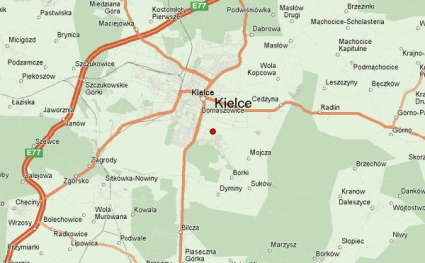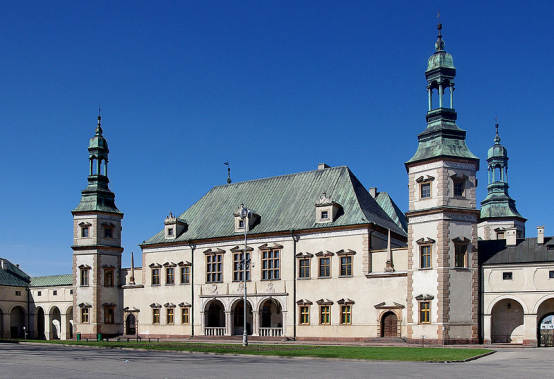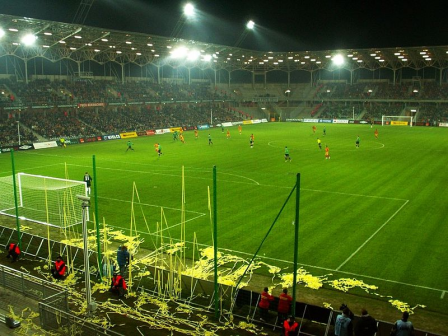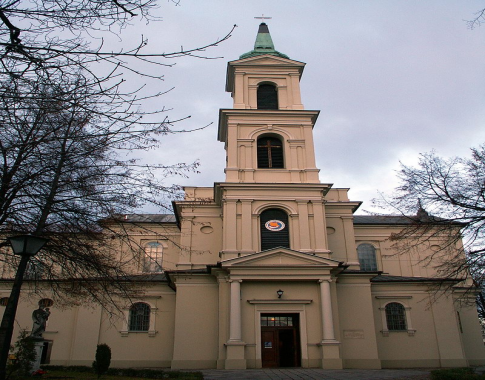Kielce-Świętokrzyskie 作者: 来源: 发布时间:2021-05-19
Ⅰ. Population and Area
Population (31 December 2019)
• City 194,852 Decrease (18th)
Area
• City 109.65 km2 (42.34 sq mi)
Website: http://www.um.kielce.pl
Ⅱ.Natural Geography
- Kielce , the largest city of Małopolska is also the capital of the Świętokrzyskie Voivodeship. Within the city limits there are the following mountain ranges: Kadzielniańskie, covered with beech and fir forests, Dymińskie, Posowickie: Grzbiet Szydłówkowski. In the north, the city reaches the wooded Tumlińskie Hills and the Masłowski Range, in the south-west the border runs along the ridge of Zgórskie Góry. The highest hill in Kielce, Mount Telegraf (406 m above sea level), lies in the Dymiński range. The Silnica River flows through Kielce, with its sources on the southern slope of Mount Sosnowica, flowing in the south-western part of the city into the Bobrza River, which along with another tributary - the Sufraganiec River, flows around the city from the west.

-It is the city located in the heart of the oldest European mountains - Świętokrzyskie Mountains called also as the Holy Cross Mountains. It is the capital of Świętokrzyskie Province and the main city in Kielce Metropoitan Area.
The region of Kielce, the northern part of Little Poland, is situated between the rivers Vistula and Pilica. Because of the landform features, it can be divided into the Świętokrzyskie Mountains, which are the culmination of the Kielce-Sandomierz Upland, in the north, and the southern part – the Nida Basin.
Świętokrzyskie Mountains are a number of latitudinally stretching ranges. The most important are:
Łysogóry – the central range with the highest hills: Łysica (612 m asl.) and Łysa Góra (595 m asl); Jeleniowskie – the highest hill is Szczytniak (552 m asl); Klonowskie – Bukowa Góra (483.6 m asl); Masłowskie – Klonówka (472.6 m asl); Tumlińskie – Góra Wykieńska (400.7 m asl), Oblęgorskie – Góra Sieniewska (448.8 m asl); and the ranges: Dobrzeszowskie, Orłowińskie, Cisowskie, Ociesęckie.
The central part of the Nida Basin is the wide valley of the Nida, delimited by the Solec Basin and Szaniec Plateau in the east, and by Jędrzejów Plateau and Miechów Upland in the west.
The main rivers in the region are the Nida (151 km), with its tributaries: Łośna, Bobrza and Mierzawa, and the Kamienna (138 km).
-Transport
- Kielce is an important transport hub, and is on international and domestic routes:
DK 7 S7 Gdańsk – Elbląg – Warszawa – Radom – Kielce – Kraków – Chyżne
DK 73 Wiśniówka – Kielce – Tarnów – Pilzno – Jasło
DK 74 S74 Sulejów – Kielce – Opatów – Szczebrzeszyn – Zamość – and from there to the Ukraine
Provincial roads:
DW 745 Dąbrowa – Masłów – Radlin
DW 761 Kielce – Piekoszów
DW 762 Kielce – Chęciny – Małogoszcz
DW 764 Kielce – Suków – Raków – Staszów – Połaniec
DW 786 Kielce – Ruda Strawczyńska – Łopuszno – Włoszczowa – Koniecpol – Święta Anna – Częstochowa
In addition, Kielce has a network of district roads, covering 109 streets with a total length of 114.9 km (71.4 mi) and a network of roads covering 446 streets with a total length of 220.9 km (137.3 mi). 57.5% of roads in the city has an improved hard surface, 8.4% of hard surface is not improved, while 34.1% are dirt.
Railways
Rail transport came to Kielce in 1885, when the construction of the line linking Iwanogród (Dęblin) and Dąbrowa Górnicza was completed. Currently, Kielce is an important intersection of railway lines, running to Częstochowa and Lubliniec, Warsaw, Kraków and Sandomierz. Within the administrative boundaries of the city there are the following railway stations: Kielce, Kielce Piaski, Kielce Białogon, Kielce Herbskie, Kielce Ślichowice.
Air travel
At present, air services are only available to the residents of Kielce at Kielce-Masłów Airport, a civilian airport located in nearby Masłów. It is not able to accommodate large passenger planes, because its runway is only 1,200 m. Its reconstruction is seen as not viable and in June 2006 the decision was made about the location of a new airport near the village of the Obice Morawica, able to handle regular airlines. At present, land has been purchased for the investment. The nearest international airports are located in Kraków-Balice, Warsaw-Okecie and Rzeszów-Jasionka.
Local transport
Official transport services were first established on 22 July 1951, when the local transport department was created.
After many changes today, the city operates 49 regular bus lines (1-53 without 34, 46, 50, 51), 13 new low-decked bus lines with text&audio passenger-information system (102-114), 5 hybrid bus lines with text&audio passenger-information system (34, 46, 50, 51, 54) four lines of special constants (C, F, Z, 100) and two night lines (N1, N2). The lines are operated by the Municipal Transport Company (MPK Kielce) and Kielce Bus Company Workers (KASP) under an agreement signed with the Management of Urban Transport (ZTM Kielce). In Kielce, there are two depots. The rolling stock is composed of about 165 buses.
In 2009/10 the Transport Authority in Kielce released the Polish Operational Programme Development of Eastern 2007 - 2013 project "Development of public transport system in Kielce Metropolitan Area." They bought 20 new buses - MAZ-203s and Solaris Urbino 12s, and another 20 were bought in 2010. These buses will support new lines. Part of the project, envisages installation of 24 electronic boards for bus departure times and 20 stationary ticket vending machines.
Long-distance travel
The history of communication dates back to coaches from Kielce in 1945, when the District was set up. Already in 1946, there were regular routes to Kraków, Warsaw, Jelenia Góra, Teplice and neighbouring towns.
After 1990, the Kielce Bus Station was renamed the PKS Station in Kielce, and has maintained regular passenger long-distance routes.
Ⅲ.Economy
-GDP 2017
Total Nominal: €10 billion
-PPP: $11 billion
Per capita Nominal: €14,900
PPP: $16,600
-Kielce - the capital city of the Świętokrzyskie Voivodship - is home to 200,000 residents. It is located in south-eastern Poland, near major agglomerations including Warsaw, Lodz, Katowice and Krakow.
-The wealth and diversity of its resources make the region rank with the top potential investment areas in the country. This opportunity has been seized by companies working in the BPO sector, as well as construction and metallurgy businesses and investors in the field of congresses and exhibitions, as well as healthcare services.
-Climate for business
-The authorities of Kielce have been making a lot of effort to create positive image of the city friendly towards new investments, innovative enterprises and working in the sphere of modern outsourcing services.
-Kielce Technology Park, which operates within the Starachowice Special Economic Zone, has had new headquarters and technical base since 2012. Kielce’s pride, Kielce Fairs has been contributing to dynamic economic development of the whole region for years.
-Within the structures of the Kielce City Hall there is the Investor Assistance Centre (COI) that aims at ensuring high quality of investment and post-investment services for entrepreneurs localising branches of their companies in the city.
-Kielecki Portal Gospodarczy / Why Kielce http://www.invest.kielce.pl/why-kielce
-Economic Data
-The City of Kielce is the capital of the Świętokrzyskie Voivodship, which is home to 1.3 million people. 20,000 students study at 10 colleges and universities located across the region and 7.000 people graduate every year.
-The net monthly salary in the corporate sector amounts to 4 261 PLN gross and the unemployment rate stands at 5.3%.
-There are more than 28,430 active businesses operating in Kielce (146 businesses per 1,000 residents).
-(April 2019)
-Kielecki Portal Gospodarczy / Economic Data http://www.invest.kielce.pl/economic-data
Ⅳ.Industrial Characteristics
-Steel, machinery and precision industry andConstruction industry
-The Kielce machinery industry has been developing well and has good prospects.
-The investment in the sector are on the increase, manufacturing plants grow and, and thus, create new jobs. In addition, the proximity of the giant market behind the eastern border of the European Union is one of the competitive advantages of Eastern Poland, including the Region as a place to locate machinery sector plants.
-Kielce’s machinery sector includes a number of different industries, especially machine and precision industry, cast manufacturing, pipes, fittings, rolling ball bearings and speciality vehicles.
-Important features of construction industry of the Region, providing attractive conditions for investment is in this sector, are relatively low labour costs. The average gross monthly salary in the construction sector in Kielce was 2 818,32 PLN (2014).
-In Kielce there are foreign construction companies such as the Swedish company Skanska S.A., but also a group of large companies with Polish capital develops successfully.
-Key project
-1. The investment projects planned for the next two years include the construction of A-class buildings with a surface area of 36,000 square meters
-Business infrastructure is one of Kielce’s strong points. The investment projects planned for the next two years include the construction of A-class buildings with a surface area of 36,000 square meters. Today, the total available office space (mostly in B+/B-class buildings) amounts to 74,000 m2. Kielce’s office property market still offers highly competitive prices, especially when compared to mature markets such as Warsaw, Wroclaw, Poznan or Krakow. Average lease rates in the city amount to ca. PLN 35-43 per m2.
- 2. A total of 30 km of roads will be built within the city limits, including 5 km constructed as part of national roads.
-Between 2007 and 2013 Kielce spent PLN 1.4 billion on road infrastructure projects. In the new financial perspective, i.e. from 2014 to 2020, a total of 30 km of roads will be built within the city limits, including 5 km constructed as part of national roads.
-3. The S7 expressway
-The S7 expressway is the region’s priority. 14 ring roads are also planned, including the ongoing construction of the ring-road of Radom, along with three new ring roads in Opatów, Morawica and Ostrowiec Świętokrzyski.
-Kielecki Portal Gospodarczy / Construction industry http://www.invest.kielce.pl/construction_industry
Ⅴ.Attrations and Cityscape

Palace of the Kraków Bishops in Kielce

Football stadium in Kielce

St. Adalbert Church dating back to 10th century
-Tourist attractions
Palace of the Kraków Bishops in Kielce
Palace of the Kraków Bishops in Kielce (1637–1641): summer residence of Bishops of Kraków, built in early baroque style by Giovanni Battista Trevano and Tomasz Poncino; houses a museum with an important gallery of Polish paintings
Baroque Cathedral (12th century, rebuilt 1632–1635 and again in the 19th century)
Holy Trinity Church (1640–1644)
Tomasz Zieliński romantic manor (1846–1858)
Old Town market (18th century) with the best, traditional bakery in Kielce, famous for its bagels
Sienkiewicza Street
Stefan Żeromski museum
Synagogue built in 1902
Geopark Kielce with the Center of Geoeducation
5 geological nature reserves in town area
Kadzielnia Gorge (a former quarry where many of the East German westerns were filmed)
Holy Cross Mountains Article with photo gallery about Holy Cross
Monastery of Karczówka-An interesting article and photo gallery of the Monastery on Karczówka
Ⅵ.History and Culture
-The exact date of the foundation of Kielce is difficult to determine. Archaeological research indicates that the town was started by a small settlement that had existed here much earlier, which developed as a place of trade exchange. Hunters and beekeepers living in the Świętokrzyskie Forest exchanged the fruits of their labor for grain and other goods. The industrial traditions of Kielce also go back to ancient times. They were still a hard-to-reach forest settlement in the forests of the Świętokrzyskie Foothills, when the ore was already smelted here.
-In the 10th century , the church of St. Wojciech. At the turn of the 10th and 11th centuries, the bishops of Kraków became the owners of the settlement along with a significant area of the Świętokrzyskie Mountains, who Palace of the Krakow Bishopsbuilt a collegiate church on the hill, now called the castle dedicated to the Blessed Virgin Mary. The Polish historian, Jan Długosz, noted "Bishop Gedeon of Krakow, wanting to extend the honor of God righteous in his diocese, built the city of Kielce in the vast forests of the time, uninhabited by people, and erected a refined and ornamental church of hewn stone". The work was completed in 1171 and this is the first certain date in the history of Kielce. Bishop Wincenty Kadłubekhe moved the parish here from the church of St. Adalbert, and then with a document from 1213, he took the canonical prebend from Kij and established it in Kyelciam. There were 4 prelates and 6 canons connected with the collegiate church, endowed with prebends in the form of nearby villages. The economic life of Kielce revived significantly, fairs, indulgences and fairs were held here. In 1229, a parish nursery was established at the collegiate church, among the pupils of which was a famous historian - Wincenty from Kielce . The great development was stopped in the middle of the 13th century by the Tatar invasions and the struggle for the throne between Konrad Mazowiecki and Bolesław the Chaste. However, the destruction and looting did not lead to the collapse of the settlement, which quickly returned to its previous state, enriching with fortifications around the church on the castle hill.
-Kielce Market SquareNo privilege or location document for Kielce has survived. Its role was played by the privilege of Leszek the White of 1227, which allowed the establishment of settlements under German law. In 1295, the Czech King Wenceslaus II gave permission to Bishop Muscat to surround "market places" with walls and moats: Sławków, Iłża, Shield and Kielce. This document confirms the importance of Kielce as a center of the local market, and since the remaining centers were already cities under German law, it is assumed that Kielce was already a city at the end of the 13th century. An important part of the location privilege was the separation of the city from the scope of land law and its transfer to German law. Bishop Bodzanta, reorganizing the administration of the properties of Krakow rulers, transferred Kielce to the Magdeburg municipal lawin the mid- fourteenth century . For the first time, the term civitas (city) Kielce was defined in 1359. At the turn of the fourteenth and fifteenth centuries, about 300 people lived here, mainly farmers.
Ⅶ.Other Information
-Kielce is a modern, dynamically developing city that has taken advantage of the civilization leap that comes with membership in the European Union. In recent years, thanks to EU funds, investments in cultural institutions, social assistance, technical and sports infrastructure, they have become friendly to their inhabitants, tourists, businessmen and people with disabilities. Thanks to Targi Kielce, the fastest growing in Poland, for many years it has been a meeting place for the largest domestic and foreign companies representing various sectors of the economy and a place where multi-million contracts are concluded.
-Kielce is also a city of geological peculiarities. Experts call the capital of the Świętokrzyskie Voivodeship "the largest open-air geology museum". Thanks to a modern base, they also have a chance to become the Polish capital of sports. Over 30 tourist routes begin, run or end in the city. For lovers of white madness in Kielce itself and in the immediate vicinity, there are 7 modern, snow-covered slopes with lifts, equipment rentals, catering facilities and parking lots. There are also cross-country skiing trails.
-Among the numerous objects recommended for sightseeing, a special place is occupied by the National Museum located in the Palace of the Krakow Bishops and the Museum of Toys and Games, the only one of its kind in Poland, with about 30 thousand items in its collection. exhibits. It is also worth visiting the Museum of Stefan Żeromski's School Years, the Museum of the Kielce Countryside. The collection of the Contemporary Sacred Art Gallery includes works by prominent Polish artists such as Tadeusz Kantor, Władysław Hasior or Jerzy Nowosielski
Ⅷ.Contact Information
-Mayor Bogdan Wenta
-Kielce City Hall
-Rynek 1
-Kielce 25-303, POLAND
-Investors Assistance Center
-E-mail: coi@um.kielce.pl
-Phone: +48 (41) 36 76 356
-Fax: +48 (41) 36 76 552
-Office for International Affairs
-E-mail: zagranica@um.kielce.pl
-Phone: +48 (41) 36 76 573, +48 (41) 36 76 478,
-Fax: +48 (41) 36 76 552
-Kielce City Hall, Rynek 1, 25-303 Kielce
-tel. 41-36-76-553, fax 41-36-76-552
-E-mail: boi@um.kielce.pl
